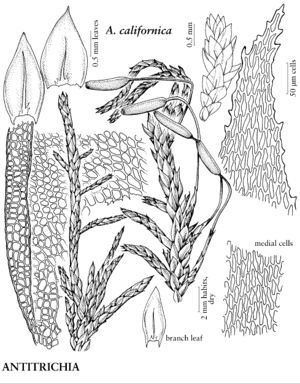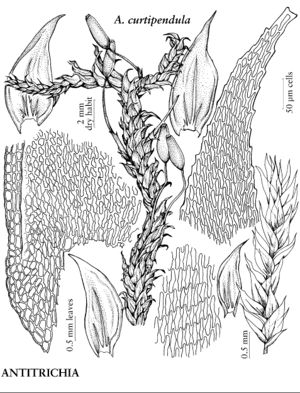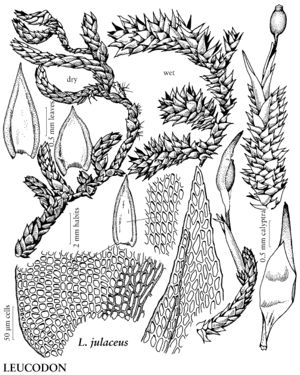FNA>Volume Importer |
FNA>Volume Importer |
||
| Line 64: | Line 64: | ||
|publication year= | |publication year= | ||
|special status= | |special status= | ||
| − | |source xml=https://jpend@bitbucket.org/aafc-mbb/fna-data-curation.git/src/ | + | |source xml=https://jpend@bitbucket.org/aafc-mbb/fna-data-curation.git/src/f6b125a955440c0872999024f038d74684f65921/coarse_grained_fna_xml/V28/V28_926.xml |
}}<!-- | }}<!-- | ||
-->[[Category:Treatment]] | -->[[Category:Treatment]] | ||
Revision as of 19:48, 24 September 2019
Plants medium-sized to large, in loose mats. Stems creeping, sympodial, stoloniferous; secondary stems ascending, irregularly branched, branches few to many, curved or in whorls; paraphyllia absent; radiculose on primary stems. Leaves crowded, imbricate when dry, spreading when moist, ovate, ovate-lanceolate, or cordate-ovate; margins entire, serrate, or serrulate; apex acuminate or acute; ecostate or costa double or more [single], short; alar cells differentiated, many; laminal cells ovate to elliptic, smooth, rarely singly papillose, or occasionally prorate, walls thick; basal cells longer. Sexual condition dioicous; perigonia axillary or borne on secondary stems or branches, deltoid-apiculate or gemmiform; perichaetia borne on main stem or lateral branches. Seta short to elongate. Capsule erect, immersed to exserted, smooth; annulus present or sometimes absent; operculum conic or oblique-rostrate; peristome double; exostome teeth 16, pale; endostome basal membrane low or absent, segments absent, weakly developed, or rarely well developed, cilia absent. Calyptra cucullate, naked or hairy. Spores anisosporous, occasionally large, papillose.
Distribution
Nearly worldwide, except Australia, Oceania, and Antarctica, temperate and tropical regions.
Discussion
Genera 7, species ca. 40 (3 genera, 6 species in the flora).
Leucodontaceae have been circumscribed variously in recent years, with the broad concept of M. G. Manuel (1974) modified by recent phylogenetic reappraisals (W. R. Buck and B. Goffinet 2000) of the taxonomic position of Alsia and Forsstroemia (in Leptodontaceae), Bestia (in Lembophyllaceae), Dendroalsia (in Cryphaeaceae), and Pseudocryphaea (in Rutenbergiaceae). The main traits of Leucodontaceae are the epiphytic habit, sympodial stems with curved, ascending secondary branches, ovate to ovate-lanceolate leaves, costa usually absent or short and double, laminal cells ovate or elliptic, thick-walled, seldom papillose, and endostome commonly reduced.
Selected References
Lower Taxa
Illustrations
Key
| 1 | Costae subpercurrent, with 2 or more shorter costae at base. | Antitrichia |
| 1 | Ecostate or costae double, short | > 2 |
| 2 | Leaf margins entire distally; laminal cells smooth or rarely slightly papillose distally over cell lumina; ecostate. | Leucodon |
| 2 | Leaf margins serrate distally; laminal cells prorate, especially distally; ecostate or costae double. | Nogopterium |


